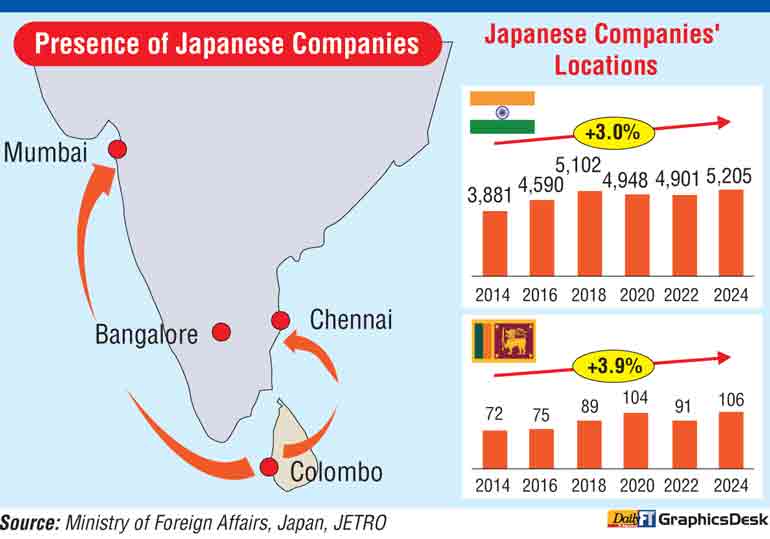Tuesday Dec 16, 2025
Tuesday Dec 16, 2025
Monday, 13 October 2025 00:00 - - {{hitsCtrl.values.hits}}


 |
| METI Director for Southwest Asia Region – Trade Policy Bureau Shimano Toshiyuki |
By Nisthar Cassim
The proposed Japan-Sri Lanka-India Export-Oriented Industrial Corridor could boost Sri Lanka’s economic growth by 9.3% by 2030, as per a study on the initiative.
The Japan-proposed corridor is envisioned as a geographically defined area connecting India and Sri Lanka, designed as a complementary collaboration among Sri Lanka, India, and Japan.
It aims to create a seamless flow for technology and investment, thereby fostering an industrial hub for global export by deeply integrating Sri Lanka into global supply chains, primarily centred on India.
This initiative is expected not only to accelerate economic growth in both Sri Lanka and India, but also create new business opportunities and enhance competitiveness for Japanese companies operating in both Sri Lanka and India, as well as those considering future expansion into the region.
There are over 5,000 Japanese companies operating in India and over 100 in Sri Lanka, and over 30% of them are engaged in manufacturing.
A conceptual roadmap has been developed by Japan’s Ministry of Economy, Trade and Industry (METI), the Japan External Trade Organisation (JETRO), and think tank Nomura Research Institute (NRI).
Japan is of the view that the corridor is a “strategic pathway for Sri Lanka” and Japan to deepen its longstanding partnership by leveraging Sri Lanka’s geographical proximity and Japan’s technological expertise and investment opportunities. Through this cooperation, Sri Lanka can transform its raw material base into higher-value products, while Japan can strengthen its role as a trusted partner in fostering sustainable and inclusive growth.
Building on this bilateral foundation, it benefits Sri Lanka to leverage its proximity, capabilities, and resources-availability to integrate into the rapidly expanding Indian and broader global supply chains.
A detailed roadmap for the corridor was formally unveiled at the Sri Lanka Business Forum held in Tokyo, with the visiting President Anura Kumara Disanayake as the Chief Guest.
METI Director for Southwest Asia Region – Trade Policy Bureau Shimano Toshiyuki in his presentation at the Forum said the roadmap is grounded in a detailed analysis of Indian import demand and Sri Lanka’s supply capabilities. The preliminary analysis focussed on India’s import dependencies and Government-supported industries while assessing Sri Lanka’s existing global exports, competitive manufacturing products, and potential for leveraging underutilised domestic raw materials. This process identified three primary target sectors: Electrical and Electronic Components, Mineral Resources and Agricultural Resources.
Toshiyuki said the proposed Export-Oriented Industrial Corridor will have a positive impact on Sri Lanka, India, and other regional countries. While the impact on Sri Lanka is a 9.3% GDP growth by 2020, the proposed initiative will boost India’s GDP by 1.28%, Bhutan’s by 0.4%, and Nepal’s by 0.2%.
According to the roadmap, the successful implementation of this initiative requires addressing a series of systemic challenges categorised as “hard” and “soft” issues.
The hard issues include logistical inefficiencies, such as delays and high costs in transporting goods to and from Colombo Port due to capacity limitations and inadequate road/rail connectivity, various energy constraints, and high mineral processing inefficiencies. The implementation plan will be proposed for addressing these issues by expanding and modernising Port facilities, improving national transport networks, enhancing energy infrastructure, and setting up dedicated industrial processing zones with mutually beneficial royalty structures.
The soft issues include regulatory complexity from burdensome and complex approval processes that require streamlined dialogue and digital solutions for regulatory clarity, a recognised gap in mutual understanding and awareness between Sri Lankan and Indian business, and regulatory practices and investment policy gaps that highlight the need for comprehensive investment incentive schemes to attract domestic and foreign capital and for a streamlined certification process to facilitate smooth trade.
The roadmap has proposed a host of future steps for realising the initiative including a multilateral working group, bilateral measures, and private sector involvement, as well as public-private initiatives.
By systematically addressing identified challenges through targeted policy interventions, infrastructure development, and coordinated dialogue, the proposed Export-Oriented Industrial Corridor will unlock significant economic benefits. It promises to advance prosperity not only for Sri Lanka and Japan, but also for India and the wider South Asia region, enhancing resilience, competitiveness, and shared opportunities in global trade.